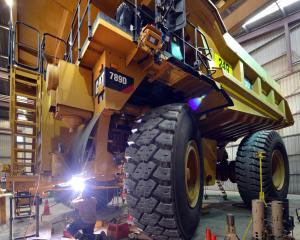West Coast mining proposals have again attracted headlines, after the Government confirmed a large aerial minerals survey includes swathes of Te Wahipounamu South West, a world heritage area.
However, neither the world heritage area, nor the most protected "Schedule 4" land in national parks under the Crown Minerals Act, would be opened to mining applications, the Ministry of Economic Development said when contacted yesterday.
The Government is becoming vocal over the importance of using New Zealand's minerals resource as a cornerstone to economic growth and recovery, lauding oil export receipts, royalties and the jobs associated with development and large miners, such as Bathurst Resources and Oceana Gold.
Almost three years ago, Government was forced to backtrack following its ill-timed announcement that Schedule 4 national parks' land may be reconsidered for mining, prompting protest around the country.
This time the Government is on the front foot, saying heritage or Schedule 4 land will not be mined. However, Green Party mining spokeswoman Catherine Delahunty's written questions in Parliament prompted confirmation of the West Coast survey, which is under way.
The $1.67 million survey covers Haast to Karamea, including parts of Te Wahipounamu. Land excluded, under Schedule 4, includes Fiordland National Park, Mount Aspiring National Park, Aoraki/Mount Cook National Park, and the Westland Tai Poutini National Park.
A ministry spokeswoman said "The survey does include the Te Wahipounamu/South West New Zealand World Heritage Area, but that area will not be part of any future competitive minerals tender that may be offered." The survey data, to be free and publicly available by about May next year, has applications for geological mapping, forestry, agriculture and horticulture, geological hazard assessment, engineering and construction investigations, and minerals exploration, she said.
The Government has just completed an aeromagnetic survey, measuring the earth's magnetism and natural radiation levels, in Northland. In 2007, about 18,000sq km of Otago were similarly surveyed by explorer Glass Earth Gold, in a $4 million project which included $1 million from the Otago Regional Council.
Yesterday, in response to the aerial survey announcement, Labour and the Green Party rounded on the proposal.
"The reality is that [survey] investigation leads to excavation," Labour conservation spokeswoman Ruth Dyson said.
While the surveying itself would do no harm "there is only one reason for this investigation and that is the future potential for exploration", she said.
Both parties called for the world heritage site to come under the same, or similar, protections afforded Schedule 4 land. Ms Delahunty said Schedule 4 was "a list of our most precious and high value conservation lands".
"Why would the Government spend taxpayer money to survey for minerals within a world heritage area unless the Government was prepared to dig it up?"
Te Wahipounamu is one of 183 natural heritage properties which the World Heritage Committee considers having outstanding universal value.
West Coast coal miner Bathurst Resources is battling environmental groups opposed to its raft of granted resource consent and has lodged evidence in the Environment Court.





